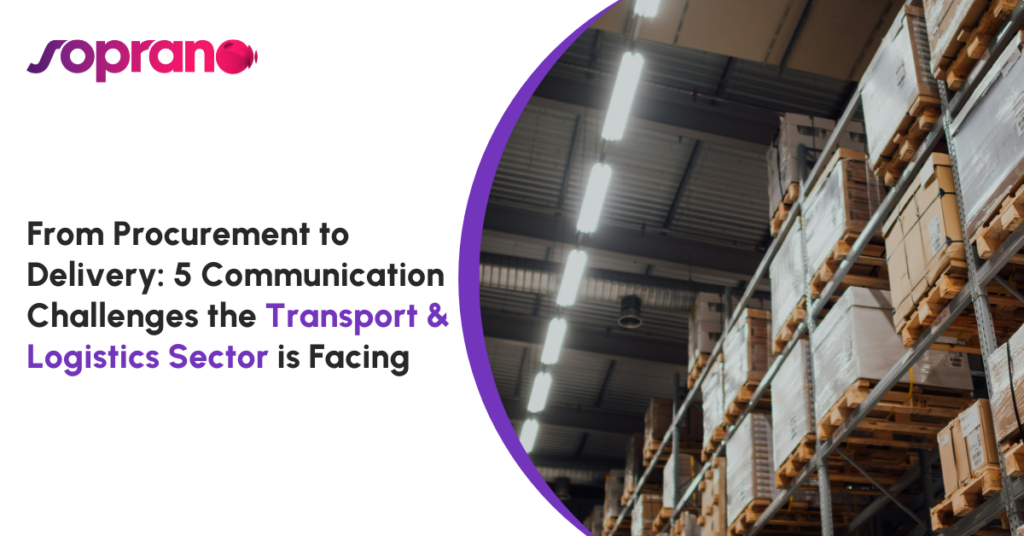
The materials that build our cities, the foods that fill our supermarkets and the fuel that powers our vehicles – everything in our lives depends on a transport and logistics sector that operates efficiently.
But despite its market size expected to exceed US$14.08 trillion by 2028, the logistics sector is naturally susceptible to instability and volatility in a way that many other industries aren’t.
A shipping port closed due to adverse weather conditions in Asia can send a ripple effect across the world and prevent a consumer in the UK from receiving their parcel on time.
Frustrating, yes. Avoidable, often no…
But what is avoidable is the degree to which supply chain disruptions impact your operations.
By having the right communication procedures in place for when things don’t go to plan, you can safeguard your business and mitigate the risks of any service disruptions that are out of your control.
So what do those procedures look like and how can they help you tackle the 5 main communication challenges facing the transport and logistics sector?
Well, that’s what we’re going to explore in this blog post…
1. Meeting Growing Consumer Expectations
One of – if not the biggest – communication challenge facing transport and logistics companies is meeting growing consumer expectations.
Go back 20 years and customers were happy if their product got from A to B on time with a simple shipping email notifying them that their parcel was on the way.
But fast forward to today where everything in our lives is readily available and consumers expect more.
They expect more transparency from logistics companies and want to be updated on their order’s whereabouts during every stage of the delivery journey from the moment they hit ‘Order Now.’
They expect to be kept in the loop if there is a hold-up with their parcel and they want to be able to choose the specific location of where that parcel is left if they’re not home to collect it.
All this added expectation puts pressure on transportation and logistics companies to provide their customers with the level of interaction they crave.
But with that added pressure, comes significant opportunity.
Because every touchpoint and every interaction you have with your customers – whether that’s a short SMS update or a conversational AI-powered chatbot that helps answer their questions – presents an opportunity for you to create a memorable experience.
You only have to look at how successful Amazon’s approach to customer experience has been in recent years to see the importance of meeting the rapidly growing expectations of your customer base.
By communicating with your customers on their preferred channel and ensuring that every interaction is packed full of value, you’ll be able to meet their growing needs, keep them happy and ensure they keep using your service.
2. Breaking Down Supply Chain Siloes
Unfortunately for transportation and logistics companies, the complex and fragmented nature of supply chains can easily lead to communication and data becoming siloed.
With different teams speaking different languages across different time zones, it’s easy to understand why this is the case.
These communication siloes can result in delays, errors, and inefficiencies that impact the entire supply chain, from procurement to delivery.
Let’s say a procurement team based in one country delays sharing critical shipment information with a warehouse team based in another.
This could lead to inventory shortages, delayed order fulfillment or missed delivery deadlines which in turn results in unhappy customers.
Not good.
But by putting communication protocols in place that increase visibility and break down supply chain siloes, you can avoid information bottlenecks, operate with more agility and act proactively instead of reactively.
This could look include sending SMS notifications to haulers or having two-way WhatsApp conversations notifying drivers of route changes or weather alerts to ensure products are delivered on time.
Whatever specific communication solution your business requires, it’s widely agreed that increasing supply chain visibility can yield the best ROI in terms of operational optimisations.
3. Leveraging Technology to Counter Labour Shortages
Labor shortages are being felt across many sectors, and it’s no different for transportation and logistics.
There are approximately 3 million global truck driver positions currently unfilled and that number is expected to rise steadily as the average age across the logistics sector steadily increases.
When you add increasing driver demand due to the growth of e-commerce into the mix, you can see why labour shortages are giving companies headaches…
But there is a solution.
One of the key strategies logistics companies are using to counter the impact of driver shortages is leveraging technology, particularly Conversational AI, into their recruitment processes.
With a lack of interest in driver positions from younger workers, many HR teams are using Conversational AI and recruitment chatbots to help them identify, screen, and hire existing driver talent.
These AI-powered tools can handle tasks in your recruitment workflow that currently require human input – like obtaining key candidate information including driver experience, safety records and certifications – freeing up your HR teams to focus on tasks that demand their attention.
The outcome of this is a smoother candidate experience and a shorter onboarding time, huge for filling vacant roles in your driver fleet and minimising any disruption to your operations.
If you’ve been thinking about introducing AI into your workflows but haven’t been sure how to, implementing Conversational AI into your HR processes is a great place to start and will likely have a snowball effect – we’ve seen this firsthand when implementing Conversational AI solutions for HR teams across the world.
Doing so will help you address immediate labor shortages and build a sustainable workforce for the future, ensuring your business remains competitive, agile, and well-equipped to navigate the evolving labour challenges of the logistics industry.
4. Keeping Up Comms During Geopolitical Events
Geopolitical events, such as conflicts, trade disputes, or political unrest, can have a significant impact on the transport and logistics sector.
You only have to look at the recent hijackings of cargo ships by Houthi rebels in the Red Sea to see how fragile trade networks are and how easily they can be affected.
During geopolitical events like the situation currently unfolding in Yemen, communication becomes even more crucial as companies need to keep stakeholders informed, adapt to changing circumstances, and make strategic decisions in real time.
This requires having efficient communication systems in place that enable seamless information flow across the teams, partners, and customers.
That could include:
- Sending out rapid SMS alerts warning freight managers of road closures or route diversions.
- Automating voice calls to relevant suppliers or stakeholders, notifying them of disruptions further up the supply chain.
- Sending bulk email updates to customers, informing them about service disruptions.
Taking a proactive approach to communication not only protects your workforce and back-end operation, it also provides your customers with a better, more transparent service, increasing brand loyalty and retention.
As discussed earlier, preventing geopolitical events from happening is all but impossible, but limiting their impact isn’t – that’s where clever communication comes in.
5. Tackling Increasingly Complex Supplier Networks
As global supply chains become more intricate, managing supplier networks and maintaining relationships is more difficult for transport and logistics companies than ever before.
The traditional linear model of supplier relationships has evolved into a complex web of interconnected entities that each have their own communication preferences.
A manufacturing warehouse may favour communicating predominantly via voice while a 3PL provider may prefer keeping in contact with its customers over email.
Zoom out and you have an entire supplier network spread out across multiple countries and multiple time zones all understandably focusing on their specific responsibility.
As these supplier networks grow more intricate, the need for seamless communication becomes even more important.
This is where Communication Platform as a Service (CPaaS) comes into play, providing transport and logistics companies with a unified communication solution that helps bring supplier networks closer together.
By integrating CPaaS into your operations, you can streamline your operations by meeting your entire supplier network on their chosen channel.
The end result?
Better communication, better operational efficiency and – ultimately – happier customers.
Soprano’s Communication Solution for the Transport and Logistics Sector
As you can see from the topics covered throughout this blog, there are several key communication challenges facing the transport and logistics sector.
The good news is there are solutions out there that can help you tackle them — our CPaaS platform, Soprano Connect being one of them.
Soprano Connect is already being used by some of the world’s biggest transport and logistics companies to improve their communication with customers, suppliers and employees, and we’re confident it can help your business too.
If you’d like to discover more about any of the solutions mentioned in this blog post and how they would fit into your workflows, get in touch with one of our solutions specialists and they’ll answer any questions you have!
